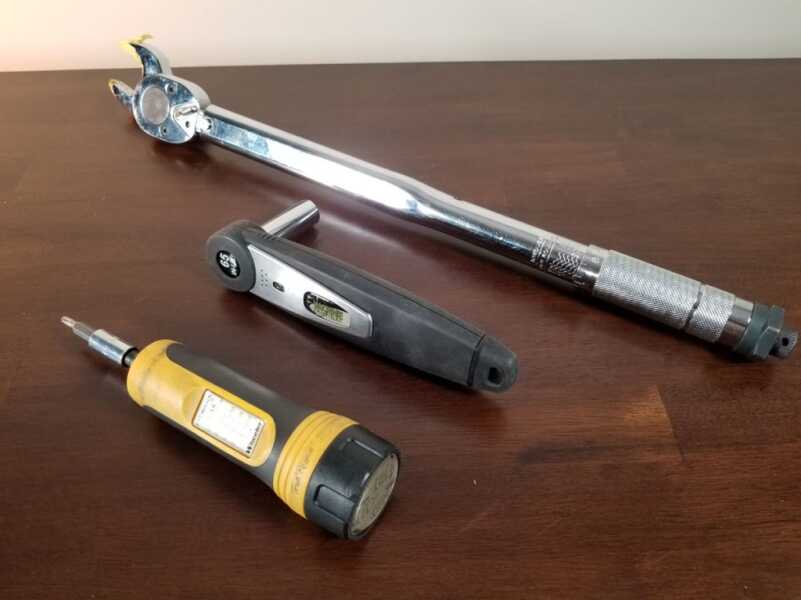There’s nothing worse than having the zero on your rifle shift or change. I’ve had it happen on several occasions and it can be a frustrating experience. Below are three things that I’ve started doing that have helped prevent loss of zero on my rifles.
One
Torque your stock screws to the proper torque specs as per the manufacturer. Check them regularly and always torque them to the same specification each time you have your gun apart. If your stock isn’t properly torqued the action can move inside the stock causing point-of-impact shifts. Remember with the screws and bolts on guns that we use inch pounds and not foot pounds We use foot pound torque wrenches on barrels and barrel nuts. Most automobile torque wrenches are in foot-pounds.

From Left to Right: Wheeler Engineering torque wrench, Warne 65 inch-pounds torque wrench and a foot-pounds torque wrench for barrels and barrel nuts.
It’s always best to go with your stock or rifle manufactures suggested torque settings. As a rule of thumb if your stock has an aluminum bedding block the front action screw is 55-60 inch pounds and the rear is 25-35. Always start by torquing the front action screw (the one closest to the muzzle) first. If you have a wood or fiberglass stock without pillars, you will be torquing at a substantially lower number. If you overtighten you’ll get stock crush which can lead to all kinds of problems. You can usually get the torque spec from the manufacturer.
As an interesting side note, an effective way of adjusting harmonics is to play with your stock torque settings. You might find that your rifle shoots tighter groups when the stock bolts are torqued to the “sweet spot.”
On non-traditional modern sporting rifles (ARs) make sure your barrel nut and handguard are tight and torqued properly. Loose barrel nuts are the first thing I look for in ARs that are shooting erratic groups or that have zero shifts. It’s a surprisingly common problem.
Two
Use a torque wrench on your scope mount bases and rings to ensure that they are tight enough but that you aren’t going to strip them out. A number of years ago, as a poor college student, I had saved the money for a 26-inch, heavy-barreled Savage 223. I didn’t have a torque wrench and I stripped out one of the receiver screws when installing the scope mount base before even getting to shoot it. It turned into a real ordeal and a learning experience. My next purchase was a torque wrench. The idea here is that with small fine threads you can stretch/distort the threads or in a worst-case scenario strip them if you overtighten them. On the other hand, if you don’t get them tight enough they’ll come loose. You really need a torque wrench to do this properly.
I had a hunting buddy miss a great buck four times and finally give up in disgust. Back at camp we examined his rifle and found that the front screws on his scope mount had come loose. He’d lost his zero and every time the rifle fired it moved the position of the scope so that the shots went all over the place. It seems like you’d notice this but it wasn’t obvious.
When tightening scope rings, if you over tighten, you run the risk of stripping the ring and/or damaging your scope. Most rifle scopes are made with aluminum bodies that are machined to be in specific tolerances. When you overtighten a scope ring you can crush, pinch, or distort the scope body which can lead to failure of the scope to hold zero, track, etc. The internals of the scope have to move inside the tube and if you’ve created a “tight spot” it can be problematic. So, don’t overtighten your scope rings.
I once had a scope manufacturer tell me that 95% percent of the problems they’d seen with their scopes were related to improper mounting and damage from scope rings.
Always follow the manufacturer’s torque recommendations for scope mount bases and scope rings.
As a rule of thumb, most scope mount bases should be torqued to no more than 15-inch pounds. Most scope rings should be torqued to 20-inch pounds. Obviously, the thread pitch, screw size, and materials used (steel vs aluminum) will make a difference. It’s likely that you’ll see small differences from one manufacturer to the next and you should always follow the manufacturer’s recommendations if they are available.
Three
Use blue Loctite on everything with a thread. Vibration from shooting, recoil, driving, four wheelers, scabbards, backpacks, flying, and temperature changes can cause movement in threaded fasteners. I use blue Loctite on everything and have literally been problem free since I started doing it. My hunting rifle does hundreds of GPS tracked miles in a scabbard on a horse each year. It hits trees, brush, and has constant motion from the horse. Not only does the blue Loctite prevent screws and threaded fasteners from loosening, but it also seals the threads preventing rust, dirt, and debris from getting into the threads. Before using the blue Loctite wipe oil from threaded parts.
I use Loctite and proper torque settings on scope mount bases and rings, stock screws, AR-15 handguards, grips, buttstock parts, and literally anything else that could come loose. I shoot thousands and thousands of rounds a year and have found it to be one of the most important things I can do to be problem free at matches or in the field.
Please leave a comment if you have a story of something coming loose or a good tip for maintaining zero on your rifle.





Your post is extremely great and get a very useful information. keep sharing this post. Keep sharing. I visit again on your website
I’ve read some good stuff here. Definitely worth bookmarking for revisiting. I surprise how much effort you put to create such a great informative website.
http://www.mumbaiescortshub.in/
mumbai is one of the most happening place in India for fun, joy and services, services like which gives you pleasure a lot of pleasure.
http://www.mumbaiescortshub.in/
It is the best information I ever read because it is very useful and informative. Keep doing the great work up.
This is an awesome driving article. I am fundamentally content with your amazing work. You put a truly amazingly consistent article.
Such a great tips this is Thanks for provide us.
Blue Loctite is not technically correct, as there is more than one type of blue. Specifically, use Loctite 220, good for small fasteners up to 1/4″. It is imperative the threads are clean on both sides, or the Loctite will be useless.
Please stop promoting “red” or ” blue” Loctite. There is a specific number for the various types.
thanks for this post
Your article if really impressive helpful for the rifle lovers, Thanks for sharing with us.
True,
Great article re keeping scopes zeroed. I am a great fan of Loctite, however, the folks at Vortex recently suggested that, if I use Loctite, I should use the minimum torque recommended for that screw because the wet Loctite acts like a lubricant and it is easy to over-torque screws, etc. I believe that Wheeler also suggests it in their instructions for the F.A.T. screwdriver.
Ken Jamin
That’s a good point. Essentially the Loctite acting as a lubricant would allow the screw to overtighten before the torque wrench indicates. Thanks for the comment.
Three tips to keep your rifle beautiful, you should note
I own a model 70 Norma magnum with two stripped scope base mount holes what is the best way to correct this problem?
The best way to fix this is drill and tap your rifle receiver for the next biggest screw size. You may also need to open up the hole size on the scope base. The safest way would be to pay a gunsmith to do it but you can do it yourself if you go slow and have the proper tools. Good luck!
Thank you for the advice i think that the barrel may have to be removed anyway so probably going to have a gunsmith repair it for me
I use High-Temperature Rocksett, Adhesive Ceramic Cement in place of Blue Loctite for any fastener that will see a temperature rise. Blue Loctite (and Red Loctite) will not hold up nearly as well as Rocksett.
Rocksett does not require the use of heat in order to allow for disassembly. I even use Rocksett to lock my muzzle devices in place for AR barrels. To date; I have never had a screw/bolt come loose on a build using this product.
Torque fasteners: great.
Blue Locktite is okay but Mfg recommends it for fasteners from 1/4 (6mm) to 3/4 (19mm): many scope/mount fasteners have smaller threaded shanks.
Question: Even with both applied, HOW DO YOU KNOW THE FASTENERS ARE STILL PROPERLY TIGHT AFTER LOTS OF MILES, BUMPS, DROPS BAGGAGE HANDLERS/EQUIPMENT AND SO ON?
Answer: Apply a fine straight line of Torque-Seal (TM) from (on) the fastener to the surface of the component. At a glance, you can check the fasteners: If the line cracks and alignment shifts: the fastener has lost tightness. No need for tools to check them and we know some can’t be accessed without removing other parts. Torque-Seal is available in several colors so it can be bright & contrast or subdued.